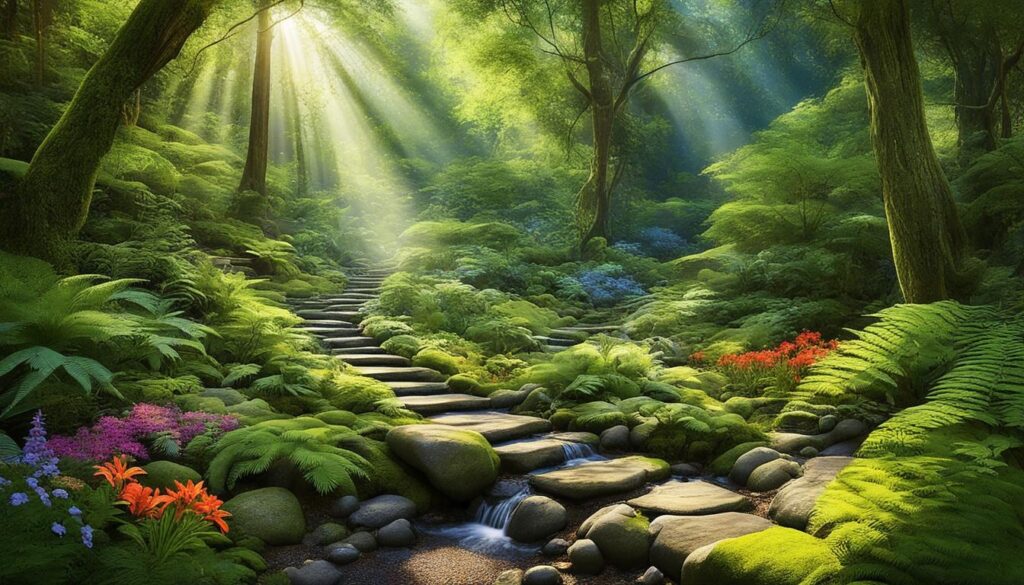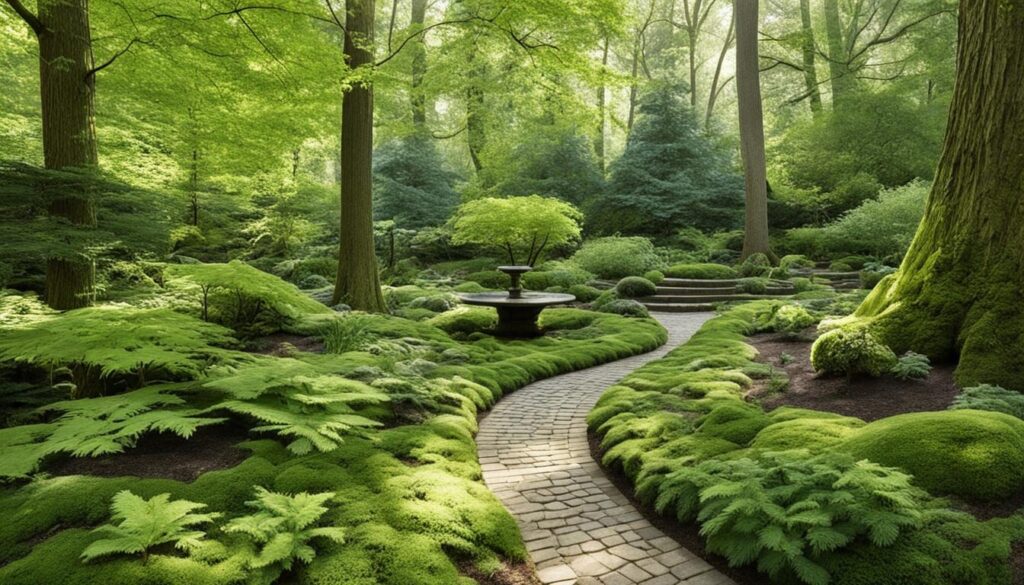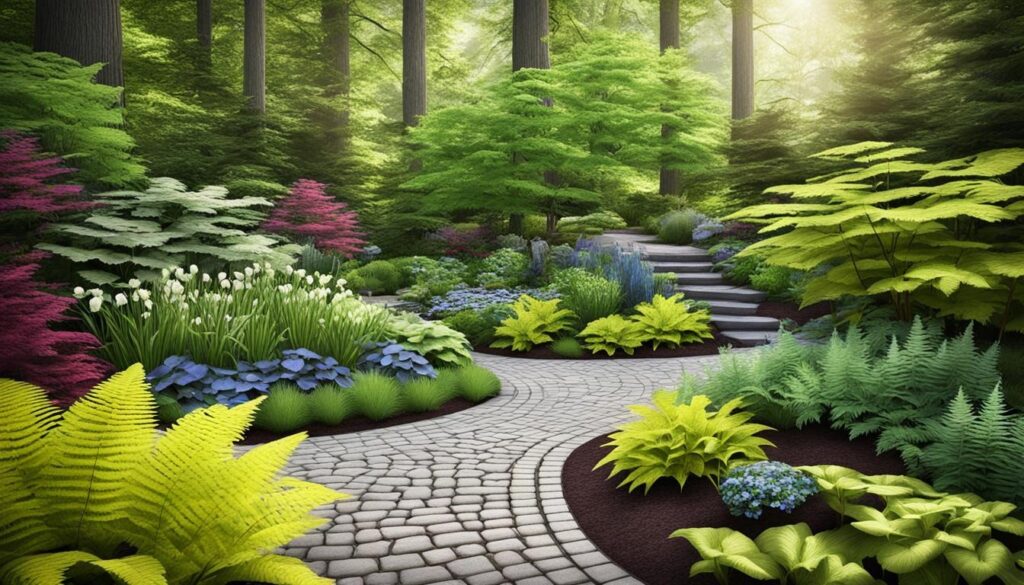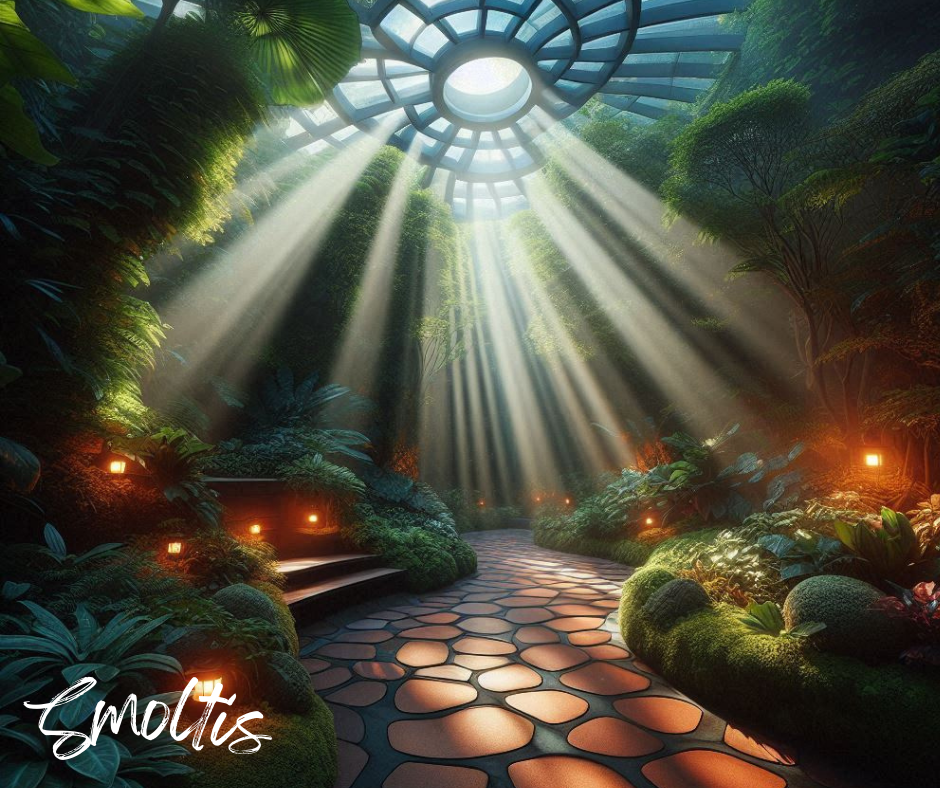Understanding light levels is key to a stunning shade garden.1 This piece looks at how to manage light, offering tips to enhance color and growth in shady spots. It covers everything from light checks to sorting shade types and using plants and structures to control light.
This detailed guide is here to help gardeners make the most of shade. It’s all about working with shade, not against it.

Key Takeaways
- Shade gardens offer a cool, inviting respite from the summer heat and are home to a wealth of wonderful plants that thrive in these conditions.
- Understanding light levels, from part shade to full shade, is crucial for selecting the appropriate plants for each area of your garden.
- Trees are valuable additions to shade gardens, as they create the desired light conditions for a wide range of shade-loving plants to flourish in the understory.
- Layering plants and incorporating structures can be effective techniques for creating and managing shade in your garden.
- Microclimates and soil conditions are important factors to consider when planning and designing a successful shade garden.
The Importance of Understanding Light Levels
It’s key to know what light levels your garden gets. This helps avoid the common issue of planting sun-loving plants where there’s shade.2 Sun-loving plants need at least six hours of direct sunlight daily. On the other hand, shade plants do well in low-light spots.2 Yet, some shade plants can handle a bit of morning sun, avoiding direct light later.2
Frustrations of Planting Sun-Loving Plants in Shade
Planting sun-lovers in the shade often leads to plants that struggle or die.2 It’s frustrating to see plants not growing or blooming because they’re not getting enough sun.
The Benefits of Embracing Shade in Your Garden
But, working with shade has its benefits.2 Shaded gardens are calm and beautiful, especially with flowers in spring and greenery in winter.2 There are many plants that love the shade and can make your garden look fantastic. By choosing the right plants, you can turn a shady area into a lush, cool spot that’s perfect for summer.
Assessing Your Garden’s Light Levels
To start, figure out how much light your garden gets each day. Watch the sun and shade move from morning to night. This helps you know where you have lots of shade or just a little.2 Then, you can pick the perfect plants for each spot, whether it’s mostly shady or sometimes sunny.2
Conducting a Daylong Light Assessment
Watch your garden at different times during the day. See which spots get lots of sun, a bit of shade, or are dark all day.2 Note places that change from shade to sun as the hours pass.2 This will show you the natural light patterns and where to put plants that love shade.
Categorizing Your Shade Levels
After you’ve checked your garden’s light, you can sort the shade types. Full sun means six or more hours of sun a day, and partial sun is four to six hours.2 Places with a little sun, two to four hours, are considered partial shade. And any spot that gets less than two hours of sunlight is just shade.2 With this info, you’ll know which plants to pick for different light conditions in your garden.
Understanding Different Shade Types
In gardens, shade varies from part shade to full shade.3 Knowing these different types helps in choosing the right plants. This is for every part of your garden.
Part Shade
Part shade gets 3-6 hours of sunlight, usually in the morning or evening.3 It’s perfect for many plants. This includes part-shade plants, shade-tolerant perennials, and some shade-loving annuals.
Dappled Shade
Dappled shade is under a tree, with light peeking through the leaves.3 It’s great for plants that like soft light. Ferns, hostas, and astilbes do well in this area.4
Summer Shade
Summer shade comes when the sunniest parts get shaded by leafy trees.3 This change in light is good for plants that prefer cooler, shadier spots in summer.
Bright Shade
Bright shade gets less than 3 hours of direct sunlight a day.3 It’s between part shade and full shade. Many part-shade plants and shade-tolerant perennials grow well here.
Full Shade
Full shade means less than 3 hours of sunlight daily. This is common under evergreen trees or on the north side of buildings.3 It’s a bit tricky, but perfect for shade-loving annuals and specific ground covers like periwinkle.
Knowing the different shade types helps gardeners pick plants that will do well in various light conditions in their garden.
The Benefits of Trees and Shade
Trees are key in any landscape for much more than shade. They cool the air through transpiration and shading,1 great for gardens. They also help animals and can boost home prices by 3 to 15%.1
In woodland garden design and understory plantings, trees are vital. They make the right light for a variety of shade-loving plants below them to prosper.1 By providing different shading levels,1 they let gardeners build a varied and rich shaded garden area.

Trees in shade gardens do more than just shade. They form a perfect spot for a mix of understory plantings to grow, making the area both beautiful and useful.15
| Shade-Tolerant Trees | Shade Characteristics |
|---|---|
| Japanese Red Maple | Dappled shade, moderate height |
| Southern Magnolia | Dense shade, tall with broad leaves |
| Red Oak | Part shade, towering height |
This table shows that trees make different kinds of shade. From the light of the Japanese Red Maple to the dense cover of the Southern Magnolia,5 choosing the right trees is key. It’s how you make a great woodland garden design for understory plantings to thrive.
Creating Shade in Your Garden
If your garden needs more shade, you can add it with structures. Things like pergolas, arbors, or shade sails help. They give the right amount of shade and make your garden look more interesting.6
Using Structures for Shade
Structures like pergolas, arbors, and shade sails work well for shade. They keep the sun away and bring a nice look to your garden. These features add style and beauty to areas that need more shade.6
Layering Plants for Shade
Layering plants is another way to create shade. Use tall perennials and climbing vines. They will shade the plants below, making a cool, green space. This way, you use your garden space well and make a beautiful, shaded area.6
Planning a Shade Garden
When you’re working on a woodland garden design or choosing plants for low-light gardening, a few things matter. These include the size of your area, your local hardiness zone, any special pockets of climate, and the soil. These steps will make sure your plants do well in shade.
Considering Garden Size
The size of your plot affects how you can arrange your shade plants. Small areas might be great for pots or small, shade-loving plants. Bigger spaces can support a variety of understory plantings and the addition of taller trees or structures for the right amount of light.1
Understanding Your Hardiness Zone
It’s key to know your hardiness zone for a woodland garden design. This info will help you pick plants that can handle your local weather. Choosing the right plants means they’ll do well through the seasons.1
Identifying Microclimates
Your shade garden may have spots with unique climates called microclimates. These areas are different in light, temperature, and moisture from the rest of your garden. Knowing about these zones can help you plant the right species in the best spots, where they can do their best.1
Assessing Soil Conditions
Soil in shaded areas might be very different from sunny spots in your yard. Testing your soil regularly is a good idea. It can tell you about the nutrients, pH, and moisture in the soil. This information helps you choose the right plants and adjust the soil as needed.1
Thinking about these points is crucial for a successful woodland garden design. It ensures your low-light gardening space is not only beautiful but also supports a wide variety of understory plantings.

Planting Shade-Loving Plants
First, know how much light your garden gets. Then, choose the right part-shade plants, shade-tolerant perennials, and shade-loving annuals for each area. They will grow well where it’s shady. You can pick from a wide range of plants that bring color to dark spots, like stinking iris and snowdrops.7
Choosing Plants for Different Light Levels
Shade-loving plants vary based on where they can grow. Some like wet shade, while others do well in dry shade.7 Plants like bellflowers and aquilegias have won awards for being great in the shade. You can get these plants at nurseries such as Jackson Nurseries and J Parker’s.7
Companion Planting in Shade Gardens
Mixing plants wisely can make your garden look good and grow well. Pair up plants that need similar light and water. This lets part-shade plants and shade-loving annuals do well together.8 It also uses the special skills of these plants, like changing how they grow when light is limited.8
Light in Shade Gardens
Shade gardens can be tricky because you need to understand different light terms like full sun or full shade.9 These terms are about how much direct sunlight plants require to grow well. You can change the light levels in your garden to help your plants thrive. This might involve pruning, adding structures, or choosing the right plants. Doing these things can make the best space for your shade-loving plants.
Understanding Light Terminology
You often hear about full sun, part sun, and full shade when talking about plants’ light needs.9 Full sun means plants get at least 6 hours of direct sunlight daily. Part sun or part shade is for areas with 3 to 6 hours of sunlight.9 Full shade gets less than 3 hours of direct sunlight, and deep shade is where sunlight barely reaches.9 Knowing these terms is key in picking the right plants for your shade garden.
Adapting Light Levels
There are several ways to adjust light in your garden for shade-loving plants.9 Trimming trees and shrubs can let in more light or make spots shadier. You can also control the light with structures like trellises or shade sails.9 Picking plants that match the light conditions, such as Hostas, can also help. This approach works for creating both a woodland or low-light style garden.
By learning about light terms and using different methods to modify light, you can make a great spot for shade plants.9 This way, your woodland or low-light garden can thrive.
Incorporating Containers and Houseplants
Containers and houseplants boost a shade garden‘s appeal, offering flexibility and a pop of life.10 They let you introduce different colors and textures into shadowy spots, not bothered by tree roots.1 For plants that live inside for most of the year, introducing them to outdoor shade slowly is a must. This way they can thrive and stay healthy.
Using Containers in Shade Gardens
10 Containers up the game in shade gardens, giving them shape and movement. They’re perfect for featuring plants that love the shade.11 Try setting out pots with bright zinnias next to purples and blues. The mix will really make your garden stand out with vibrant colors and lush textures.11 If you’re short on space, hanging pots are a win. Fill them with succulents and a pop of purple fan flower. It gives a striking look against dark containers.
Acclimating Houseplants to Outdoor Conditions
1 Having houseplants spend the summer outdoors is great. They flourish in the low-light gardening setting of a shade garden. Yet, ensure they get used to the change gradually to prevent any harm.11 Create container gardens that wow by mixing it up. Pair grassy plants with pink, blue, and vining greens. The result is a stunning display, especially when you play with contrasting colors and shapes.
Addressing Challenges of Shade Gardening
Shade gardens have many benefits, but they bring unique challenges too. These include keeping the soil fertile and dealing with pests and diseases.
Maintaining Soil Fertility
Shady spots find it hard to have rich soil due to lower light.2 Places with less than two hours of sun daily are fully shaded. This lack of light slows down soil’s natural fertility processes. So, you need to fertilize regularly and check the soil’s makeup for your plants to do well.
Dealing with Pests and Diseases
Problems like moss and slugs are common in shade gardens.12 Shady, moist areas are perfect for these pests and diseases. It’s important for gardeners to keep an eye on such issues. They need to act fast with specific solutions to keep their shade gardens healthy.
Knowing the challenges of shade gardening and tackling them head-on helps. You can have a beautiful, not-too-hard-to-keep shade garden. It can become a peaceful haven in your backyard. Using the right shade gardening techniques and low-light gardening methods, along with good woodland garden design, makes it possible. In the end, you’ll enjoy the serene beauty of a well-cared-for shade garden.
Conclusion
Understanding light levels is key to a successful shade garden. You need to know your garden’s light, pick the right plants, and use smart planting methods. This way, your shady spots will be full of life and beauty.13
Don’t fight the shade in your garden; use it to your advantage. Plant local varieties like hostas, columbine, and ferns for a natural look. But beware of invasives such as Winter Creeper and Mondo grass. They can upset the balance of your shade garden.13
Designing a woodland garden can be a rewarding project. By using the right methods, you’ll make a peaceful space that’s also good for the environment. Make the most of shade gardening; it’s full of chances to grow beautiful, hardy plants.
FAQ
What is the importance of understanding light levels in a shade garden?
Knowing your garden’s light is key for success. Lots of gardeners face problems by planting the wrong plants in shady spots. This can lead to disappointment. But, working with shade can be great. Shade gardens offer a cool break from the heat. Plus, many beautiful plants love growing there.
How can you assess the light levels in your garden?
Start by watching your garden all day. Note where the sun shines and where it’s shady. This helps you understand the light in different parts of your garden. You can then figure out which plants will do best in each area.
What are the different types of shade in a garden?
Shade in gardens varies a lot, from a little shade to no sun at all. Part shade gets 3-6 hours of sunlight every day, usually in the morning or evening.
Dappled shade comes through trees and creates a patchy light on the ground. Summer shade happens when sunny spots are later covered by tree leaves. Bright shade gets just a bit of sunlight, less than 3 hours each day.
How can trees and structures be used to create desired lighting conditions in a shade garden?
Trees do a lot more than just provide shade. They cool the air, make homes for animals, and can make your property more valuable. In a shade garden, trees are essential. They give the right light for many plants to grow well. If your garden needs more shade, you can add structures like pergolas or shade sails.
These create shadow just like trees do.
What factors should be considered when planning a shade garden?
Think about your garden’s size, where you live, and the ground’s condition. Knowing these lets you pick the best plants for your garden’s shady spots. Microclimates can change how much light and water different areas get. So, it’s important to notice these too.
How can you select the appropriate plants for a shade garden?
Understanding your garden’s light helps you choose the right plants. Many plants love shade, from flowers that come back year after year to ones you plant each spring. Mixing plants that like the same amount of light and water makes your garden look great.
How can you adapt light levels in a shade garden?
You can change how much light plants get with careful trimming, using different plants, or adding shade with structures. Potted plants can also brighten up a shade garden and give you flexibility.
What are some of the challenges of maintaining a shade garden?
Shady gardens have their own issues, like keeping soil rich and stopping pests and diseases. Less sunlight can make keeping the soil healthy hard. You might need to add more food for the plants, and watch the soil’s nutrients. Shade also attracts moss and slugs. You’ll need a plan to keep these in check.
Source Links
- https://extension.umn.edu/planting-and-growing-guides/gardening-shade
- https://extension.psu.edu/planting-in-sun-or-shade
- https://www.gardenersworld.com/plants/types-of-garden-shade/
- https://bestall.co/from-the-garden/types-of-shade-in-a-garden/
- http://extension.msstate.edu/successful-shade-gardens-0
- https://www.houzz.com/magazine/set-your-shade-garden-aglow-with-light-stsetivw-vs~13916673
- https://www.gardenersworld.com/plants/the-best-shade-loving-plants/
- https://www.rhs.org.uk/garden-design/shade-gardening
- https://www.finegardening.com/project-guides/gardening-basics/distinguishing-degrees-of-light-and-shade
- https://www.bhg.com/gardening/landscaping-projects/solving-shade/shade-garden-design-ideas/
- https://www.southernliving.com/garden/creative-container-gardens
- https://gardeningsimplifiedonair.com/episode-86-shade-is-hard/
- https://wellslawn.com/creating-a-beautiful-and-responsible-shade-garden/

